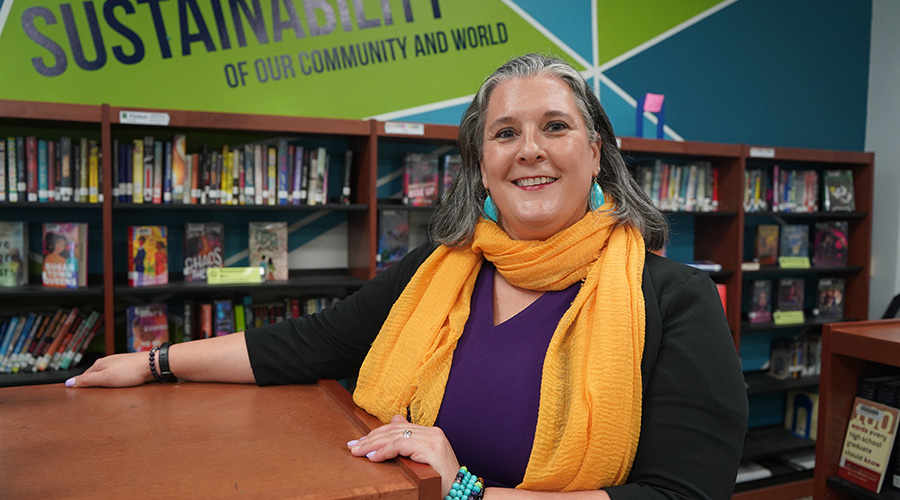Renovating Buildings, Images
A four-year facility retrofit program revamps Charleston’s schools, as well as public perception of the district’s maintenance department
Responsibility and respect go hand in hand. Maintenance departments that fulfill their responsibility to keep facilities efficient and safe will earn respect from the people who use those facilities.
Perhaps nobody understands the value of respect more than the managers and technicians in charge of maintaining the campuses of the Charleston (S.C.) School District. Over the last four years, the district has undertaken its first multi-year building program in almost 40 years.
To date, 97 percent of the district’s 78 schools have received improvements in various areas, including lighting, windows, air filtration, air-handling systems, security, and communications technology. While the project’s goal was to create healthier and more conducive learning environments for students, it also sparked admiration for the district’s maintenance department.
“The most significant area of improvement has been in public confidence and public perception in our operations,” says Mark Cobb, executive director of facility services. “I think our constituents have much more respect and confidence in what we're doing now as building operators than before this project started.”
Targeting Deferred Maintenance
Prior to the project, the district consisted of 6 million square feet. An assessment of the facilities in 1997 revealed that the cost of deferred maintenance projects had accumulated to more than $600 million.
“In a nutshell, the deferred maintenance was due to inadequate funding of the maintenance program,” Cobb says. Unable to maintain the facilities properly, the district and its maintenance department were earning an unfavorable reputation within the district’s community.
If a school is crumbling because maintenance hasn’t been funded adequately, the public naturally will form a poor perception of the school’s quality of education, says Bill Lewis, executive director of the district’s facilities improvement department. Realizing the need for improvement, the school administration and community heartily approved a comprehensive renovation program in 2000.
Since then, Charleston County taxpayers have invested $432 million in the district’s facilities. More than $50 million of that amount was invested in projects that addressed the most critical deferred maintenance projects.
“One of the smartest things we did was first create a package of projects labeled critical needs, which the board approved first,” says Lewis, who manages the capital-improvement program, as well as the relationships with the construction-management firms hired to carry out the renovations. These groups work alongside the facility services department, whose responsibilities include facility and grounds maintenance, in developing the plans and design guidelines.
The projects addressed critical issues, including inefficient HVAC systems, leaking roofs, and inadequate life-safety systems.
“Taking care of those critical issues immediately made a significant improvement in our schools,” he says. The remaining funds were used to construct 15 new schools and whole-building renovations and expansions of 26 existing schools.
Mindset Makeover
In order to guarantee success, Lewis says the entire department staff needed to contribute to the effort, pay attention to details and consider the impact facility operations has on the district’s mission.
“We wanted to adopt a corporate mindset in regard to facilities,” he says. The Walt Disney Corporation’s reputation for impeccable attention to detail has been a role model for Lewis, Cobb and their staffs.
“The facility engineers at Walt Disney think in great detail about their systems, so they are well maintained, serviceable and make a visit to the Magic Kingdom a memorable experience,” Lewis says. The Disney people are constantly reanalyzing the way they keep their facilities clean, maintained and safe. They know that even the mundane things, such as the appearance of an outdoor trash basket, can make a difference in customer perception.
“We adopted that same attitude for our schools,” Lewis says. “We think long and hard about the systems in our buildings and use our expertise, experience and benchmarking to ensure operational success.”
Several employees in facilities services department provided information and recommendations during the design and development phase.
“We were asking the public to make a huge investment in upgrading our facilities, and it is my department’s charge to protect that investment and maintain the facilities after the upgrades have been completed,” Cobb says, That is why it was imperative to talk with technicians during the beginning stages of the project.
“We collected grassroots input from the gentlemen who were turning the wrenches,” he says. “We asked them what they wanted the renovated areas to look like and what they wanted to maintain when it is complete. Their comments didn’t drive every decision, but we at least gave them the opportunity to provide input.”
Says Lewis, “Nobody knows our bathrooms better than our plumbers and custodial people.” So these workers provided a lot of inspiration when the designers began considering options for the restrooms.
“When we began comparing different flooring systems, we asked our custodial director for his advice,” Lewis says. “And when we looked at the kitchens, we talked with the food services director and incorporated his knowledge and experience into the design plans.”
During the whole-school renovation, teamwork proved to be as critical as design plans. Providing uninterrupted service to those schools was the biggest challenge for the facilities services department. Each whole-school renovation had three to five stages.
“Scheduling all of the projects and phases required incredible coordination and teamwork among the in-house staff and contractors,” Cobb says. In some cases, the district moved students and faculty to mobile classrooms and swing spaces.
“This placed a tremendous workload on our maintenance personnel,” Cobb says. “We had to shut down some of the kitchens that were being renovated. Students continued to receive hot meals that were prepared at a neighboring school and transported to the school under renovation. To date, there have been no interruptions to breakfast or lunch programs.”
Standardizing for Success
Another key to the project’s success was standardizing the various building systems throughout the district.
“We couldn’t afford to operate a district of more than 80 schools, each with different systems,” Lewis says. “We took advantage of our size in the marketplace and standardization helped us increase the quality of our systems at better prices.
Standardization also helped us build better relationships with vendors, who started treating us as a client, rather than a paycheck. One of the things that gave us a lot of bang for our buck was standardizing our playground equipment.”
The department bought and installed more than $1 million in new playground equipment at 44 schools. Before renovation, each playground had different pieces of equipment in various states of repair.
“Now, if I blindfolded you and took you to one of the playgrounds, it would be difficult for you to identify which school you were at,” Lewis says. Other items the district standardized include HVAC equipment, energy-management controls, fire alarm and fire-suppression systems, and restroom equipment.
“Standardization also goes a long way in being more efficient in employee training and reducing our amount of inventory,” Cobb adds. “Mechanics can build on their skills from each other because they’re all going through the same training. In addition to the formal training they receive from the manufacturer or from another outsource trainer, they can learn from each other on the job.”
Upholding Reputation
Now that most of renovations have been completed, the maintenance department’s goal is to uphold its newfound reputation by keeping systems operating efficiently.
The department is replacing its existing CMMS with a Web-based system that is more user friendly. It enables allows mechanics to view work orders and update the status of these work orders. The department also conducts a biannual condition assessment of facilities and equipment.
“We rank all of our facilities and condition C1 to C4,” Cobb says. “C1 represents brand new condition and C4 means that the system has deteriorated to the point where it may not support the mission of the school district.” The assessment covers a checklist of items, including roofing, HVAC, plumbing, lighting and security systems, as well as grounds care. Every category is color coded for easy recognition.
“The information is put in a data system and is the basis for our maintenance program and capital-improvement program to prioritize projects at each school,” Cobb says.
Adds Lewis, “Our design guidelines are not static. In moving forward, we’re reflecting on the things that worked well and what didn’t work as well as we thought they would.” It is important that the public maintains its confidence in the district’s building operations.
Adds Cobb, “We’ve really come a long way over last five years, and I truly believe the public confidence in what we’re doing with our facilities has improved morale. We’ve gone from really having no respect in the community because our buildings weren’t adequately funded to being recognized as department of the year by the South Carolina School Plant Management Association in 2002. It has been quite a shot in the arm in boosting our self esteem.”
Snapshot: Charleston Schools
The Charleston County School District operates 44 elementary schools, 15 middle schools, 11 high schools, and four multi-level combination schools and charter schools. It serves more than 42,000 students. In addition to nearly 7 million square feet of facilities, the department maintains more than 250 mobile classroom units and 1,200 acres of property.
Responsibilities include operational services, such as facility maintenance, custodial and grounds maintenance, school nutrition and food services, student transportation, utilities management and campus security.
The facility maintenance sector employs about 140 workers, including administrators, clerical trades and technicians.
|
Related Topics:











